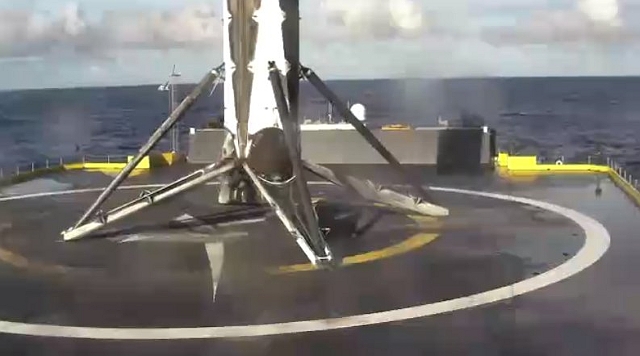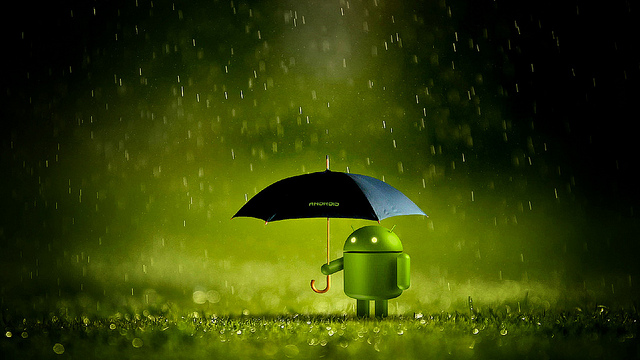Photo: SpaceX
Three (or Four) In A Row!

SpaceX is going to have to watch out, because at this point they might be making it look too easy. On Friday evening (EDT) the company followed up the successful launch of the THAICOM 8 satellite with a successful return of the Falcon 9’s first stage to a drone ship, making it the fourth recovered rocket for the company, and the third (in a row) recovered at sea. There’s still a good chance it’ll be too damaged by re-entry for re-use — the second, which also launched a satellite to the realatively high geostationary transfer orbit (GTO) sustained “max damage,” making it questionable whether recovering the first stages of Falcon 9s launching things to that challenging orbit will be of much economic use. That said, the fact that they can stick the landing even with those challenging circumstances suggests to me that they’ll find a way over this hurdle as well. In the meantime, check out the video below, a sped-up rocket’s-eye-view of the realignment, re-entry, and landing. So, so cool.
BEAM Inflated

Astronauts aboard the International Space Station completed the inflation and pressurization of the Bigelow Expandable Activity Module (BEAM) yesterday at 4:44pm EDT. There had been a few issues earlier in the week, when, on Thursday, they were forced to stop the inflation procedure because, well, it wasn’t expanding. NASA originally commissioned the module from Bigelow Aerospace back in 2012 as a way of investing in lower-cost methods of future space exploration, the goal of NASA’s Advanced Exploration Systems program. After a little delay thanks to the rapid uncontrolled disassembly of SpaceX’s CRS-7 launch and the subsequent investigative delays, the module was delivered aboard the CRS-8 mission in early April. It’s thought that the extra ten months in storage may have been the reason it wouldn’t inflate right away. Next week, ISS astronauts will check the module for leaks and then venture inside (briefly), but they won’t be using it much. The BEAM’s presence isn’t to expand the usable space on the station, but to prove the technology’s safety in space. To that end, it’ll be on the far side of an airlock for the next two years, just in case this $17.8 million balloon goes pop (it probably won’t, but just to be on the safe side). If it survives two years, NASA — and a whole lot of other people besides — may well order more. You can read more about the BEAM over at NASA.gov.
Oracle v. Google

The latest stage in the ongoing saga of Oracle v. Google concluded this week with a jury ruling that Google’s implementation of Java APIs in their Android operating system represented a fair use under copyright law. This is a pretty complicated case, but the long and short of it is that Oracle was (and continues to be) suing Google for using its APIs, or Application Programming Interfaces, within its operating system. These APIs are for the Java programming language, and essentially serve as a set of tools for programmers to work in that language. These shouldn’t really be copyrightable, but a recent federal court appeal decided that suddenly they were, and that Oracle could sue Google for reimplementing the APIs. What it probably came down to for the jury was something else, though: Java was developed by Sun Microsystems, and its president had no problem with Google using the APIs. Even when Sun was bought by Oracle, there didn’t seem to be any issue — until the competing product Oracle was building fell through. Then they decided they wanted a piece of Google’s pie, for their contribution to it, to the tune of nine billion dollars. Most people don’t understand APIs or the way most programmers consider them open for use, but they do understand when someone comes along and tries to change the terms of a deal (even an informal one), so if you ask me, that’s why it shook out the way it did. But of course with nine billion on the table, Oracle is of course appealing the ruling, so things may yet get worse for copyright in America (’twas ever thus). You can read ore about it over at the Electronic Frontier Foundation.
ICYMI
In case you missed any of it, here’s what I got up to this week:
- On Monday, I provided you with some choice quotes by Mr. David “Avocado” Wolfe on the subject of gravity
- On Tuesday, I discussed the new report out by the National Obesity Forum
- On Wednesday, I reported on the successful “day in the life” test of the Planetary Society’s Lightsail 2
- On Thursday, I talked about raising the minimum wage and the coming roboticization of the workforce, and
- On Friday, because Elle was out, I talked about complaints that theologians weren’t invited to a scientific conference
If you missed any of them, spend a little of your Sunday catching up!
Best of the Rest
Of course, there’s always more to cover than I have time for, so here’s what else has been going on this week, in linkspam form:
- Wired has a review and discussion of the new book Trekonomics, on the economics of the Star Trek universe
- Heimlich finally did the Heimlich maneuver for the first time at age 96, saving a woman from choking
- A study claims to have linked cell phone use with cancer… I’ll have more to say about that this week
- A Hungarian team of physicists might have found evidence of a fifth fundamental force
- Slate has a review of a non-sensationalist dietary science book we should all probably read
- Samsung gave us another sneak peak at the (bendy) future of screens
- The Logical Libertarian gave us an explanation of why, no, nobody’s hiding the cure for cancer for profit, and
- Netflix has decided to name and shame ISPs whose speeds are too slow with a tool for their viewers to measure their speed
***
Thanks for reading! I only get paid in my own (and your) enthusiasm, so please like This Week In Tomorrow on Facebook, follow me on Twitter @TWITomorrow, and tell your friends about the site!
If you like our posts and want to support our site, please share it with others, on Facebook, Twitter, Reddit — anywhere you think people might want to read what we’ve written. Thanks so much for reading, and have a great week.
***
Richard Ford Burley is a human, writer, and doctoral candidate at Boston College, as well as an editor at Ledger, the first academic journal devoted to Bitcoin and other cryptocurrencies. In his spare time he writes about science, skepticism, feminism, and futurism here at This Week In Tomorrow.

